When you’re diving into script formatting, you need to pay attention to a few key elements. First, always use Courier font. It’s the industry standard, easy on the eyes, and helps keep focus on your story. Next, margins matter! Stick to 1.5 inches on the left and 1 inch on the right to avoid cramping. Don’t forget clear scene headings like “INT.” or “EXT.” to set the stage; they guide readers through your world. Keep action lines short and snappy—think of it like a snack, not a feast. Intrigued? There’s so much more to explore in crafting the perfect script!
Key Highlights
- Proper script formatting enhances reader immersion and ensures focus on the story rather than layout confusion.
- Standardized fonts like Courier and Courier New maintain professionalism and readability throughout the screenplay.
- Clear scene headings (INT./EXT.) and concise action lines aid in navigating the script and visualizing the story.
- Dialogue should be indented and centered with character names in uppercase for easy identification and flow.
- Parentheticals can enrich dialogue delivery but should be used sparingly to avoid cluttering the script.
Importance of Script Formatting

Script formatting plays an essential role in the success of your screenplay. It’s like the safety gear you wear when biking; it keeps everything secure and on track. When you format your script correctly, you help readers focus on the story, not the confusing layout. Think about it: when you’re reading a script, you want to immerse yourself in the characters’ worlds, not struggle to figure out where to look next. Utilizing essential filmmaking equipment can also enhance your storytelling, as a well-prepared shoot allows you to concentrate on script quality rather than technical issues.
I remember the first time I tried writing a screenplay without proper formatting. It was a mess! My friends couldn’t follow the plot, and honestly, neither could I. Once I learned the rules and applied them, my stories began to shine. Each scene flowed smoothly, making it easier for everyone to visualize what I saw in my head.
Using standard script elements—like scene headings, action lines, and dialogue—creates a familiar environment for directors and actors. It’s like providing a roadmap for all involved, ensuring they feel safe and confident guiding through your creative vision. So, embrace script formatting! It’s not just a set of rules; it’s your ticket to sharing your stories with the world.
Standard Font Choices
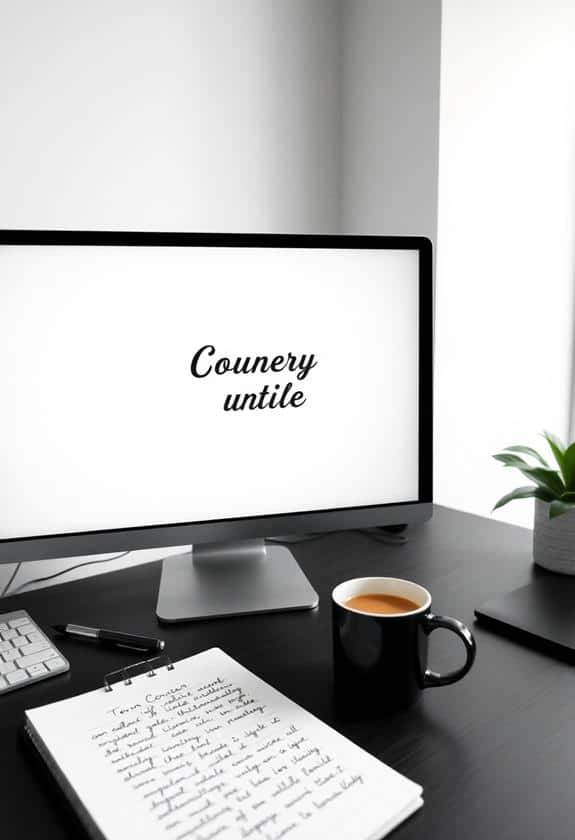
Choosing the right font for your screenplay is essential for readability and professionalism. You don’t want your brilliant story lost in an unreadable mess! Using standard font choices makes your script look polished and helps keep your readers focused on what matters—your storytelling. For those working on video editing, fun, and easy editing equipment can also enhance your overall creative process and presentation.
Here are three font choices that work wonders:
- Courier: This classic font is the industry standard. It’s typewriter-style, which means it’s easy to read and gives your script that authentic feel.
- Courier New: A modern twist on the classic Courier, it maintains the same readability but adds a little more flair. Perfect for when you want a touch of personality!
- Helvetica: If you’re feeling adventurous, this sans-serif font offers a clean, contemporary look. Just remember, it’s not as widely accepted, so use it with caution.
I remember when I first started writing, I used a fancy font that looked great but confused my readers. Stick to the basics and let your story shine. Choosing the right font is like selecting the perfect backdrop for your film—it’s the first step in creating a safe, inviting space for your audience.
Margin Specifications
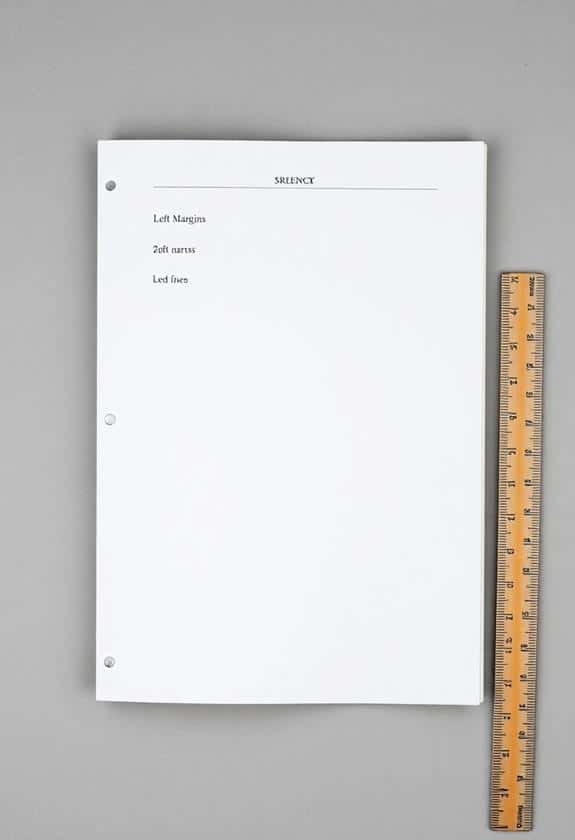
When formatting your screenplay, margin specifications play a significant role in guaranteeing your work is presented professionally. Trust me, you don’t want your brilliant ideas hidden in a sea of misaligned text! Typically, you should set your left margin to 1.5 inches, while the right one is set to 1 inch. This allows enough space for those pesky notes from agents or directors without cramping your style. Additionally, having the right tools can enhance your writing experience, so consider exploring affordable filmmaking gear that can assist you in your creative process.
The top margin should be 1 inch, and the bottom margin should also be 1 inch. This setup guarantees your pages don’t look cluttered and gives a neat appearance. Keep in mind, standardizing your margins makes it easier for readers to focus on your script without distractions.
I remember when I first started writing screenplays, I overlooked this detail and my script looked like a jigsaw puzzle. It felt so discouraging! But once I nailed those margins, my work finally felt polished. So, take a moment to set your margins correctly. It’ll save you headaches later and show you’re serious about your craft. Just think of it as giving your story the safe, cozy space it deserves!
Scene Headings
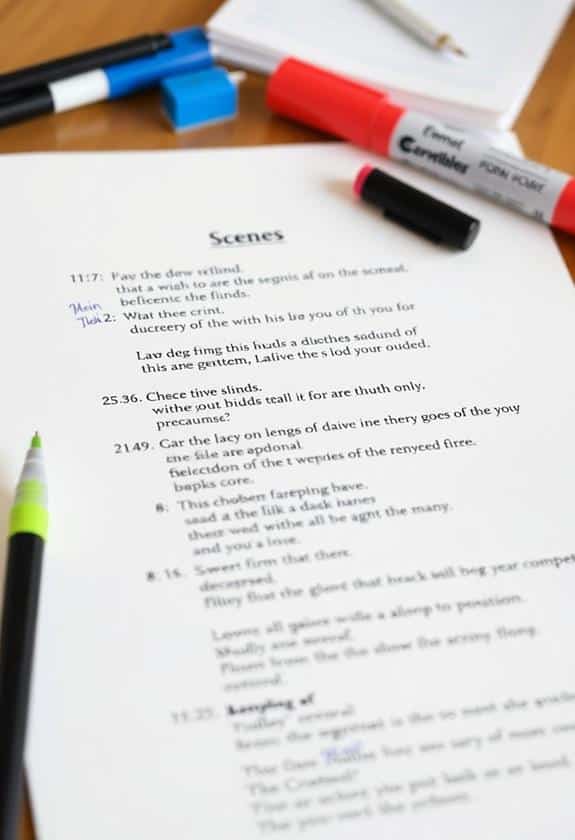
Effective scene headings are essential for clearly guiding your readers through the screenplay. Think of them as road signs that help everyone find their way, ensuring they always feel safe and secure in your story. A well-crafted scene heading sets the stage for what’s to come and makes your screenplay easy to navigate. Additionally, using proper editing equipment can enhance the overall clarity and presentation of your script, making it more appealing to potential readers and producers. Consider investing in essential editing equipment to elevate your creative process.
When writing scene headings, remember these three key elements:
- INT. or EXT. – Indicate whether the scene takes place indoors (INT.) or outdoors (EXT.). This helps the audience picture where the action unfolds.
- Location – Specify the exact place, like “CLASSROOM” or “CITY PARK.” This detail immerses your readers in the world you’ve created.
- Time of Day – Mention whether it’s “DAY” or “NIGHT.” This helps set the mood and prepares the audience for the tone of the scene.
Action Lines
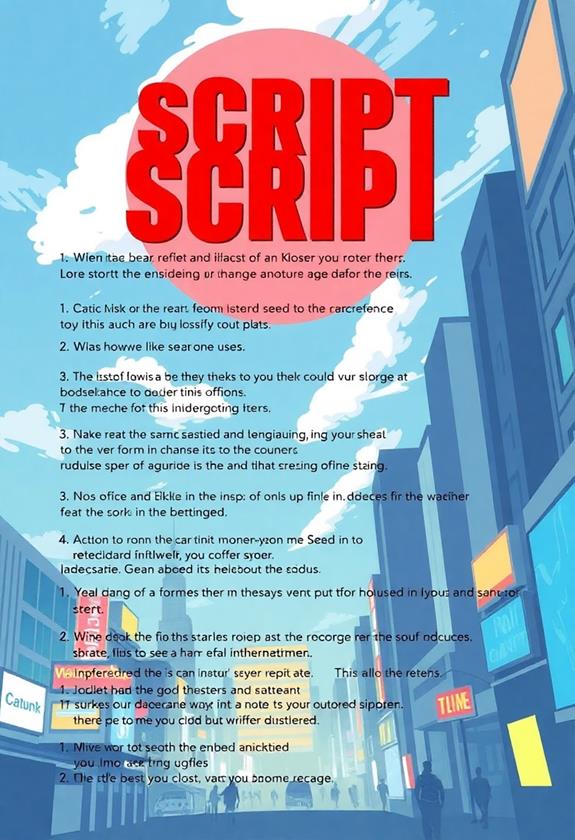
Action lines serve as the heartbeat of your screenplay, propelling the story forward and immersing readers in the unfolding drama. They describe what’s happening in a scene, letting your audience visualize every moment without overwhelming them. Keep your action lines concise and clear.
Here’s a quick guide on what to include and how to format your action lines:
| Do’s | Don’ts |
|---|---|
| Use present tense | Write in past tense |
| Be specific | Be vague |
| Focus on visual actions | Over-describe emotions |
| Keep it brief | Go on and on |
For example, instead of saying, “The man was very angry,” you could write, “John’s fists clenched, his face flushed crimson.” This paints a vivid picture without spelling everything out. When I first started writing, I struggled to find the right balance, often getting lost in details. But remember, your goal is to create a safe space where readers can lose themselves in your story. So, keep those action lines sharp, engaging, and inviting!
Character Names

Every scene thrives not just on the actions but also on the characters who inhabit it. When you’re naming your characters, you’re giving them a personality and a role that’s essential to the story. You want names that resonate and stick with your audience. Here are three tips to reflect on:
- Think about their traits: A brave character might have a strong, bold name like “Max” or “Valiant,” while a quirky character could be named “Bubbles” or “Jasper.” Just as the right camera lens can enhance your photography, the right name can enhance your character’s presence in the story.
- Reflect on the setting: If your story takes place in a historical setting, choose names that fit that time. “Elizabeth” feels far more fitting in a 19th-century novel than “Zoe.”
- Stay unique: You don’t want your characters to blend in with every other story out there. A unique name can spark curiosity and interest, making your character unforgettable.
When I was writing my first script, I struggled with names. It’s a challenge, but remember, a character’s name can set the tone for their journey. So, take your time, and have fun with it!
Dialogue Formatting
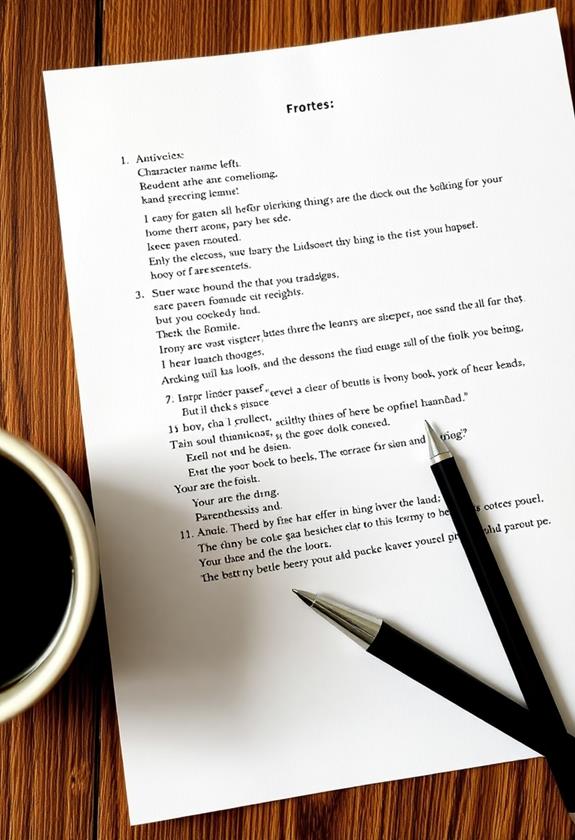
When crafting your script, nailing down dialogue formatting can make all the difference in how your characters come to life. You want your audience to feel connected, and clear dialogue helps achieve that. Start by placing your characters’ names centered and in uppercase, right before their lines. This clarity shows who’s speaking and keeps your script organized.
Now, let’s talk about how your characters should sound. Use natural language that reflects their personalities. For instance, if your character’s a quirky inventor, let their dialogue be playful and a bit scattered. It adds depth and fun! And remember, keep each line concise. No one wants to read a five-minute monologue. Think of it like a game of catch—keep it flowing!
Also, don’t forget about pacing. Short, punchy exchanges can create excitement, while longer, thoughtful lines can add tension. I once struggled with this in my first screenplay, and trust me, it’s a game changer. You’ll find the right balance through practice. So, jump in, have fun, and let your characters’ voices shine. You got this!
Parentheticals
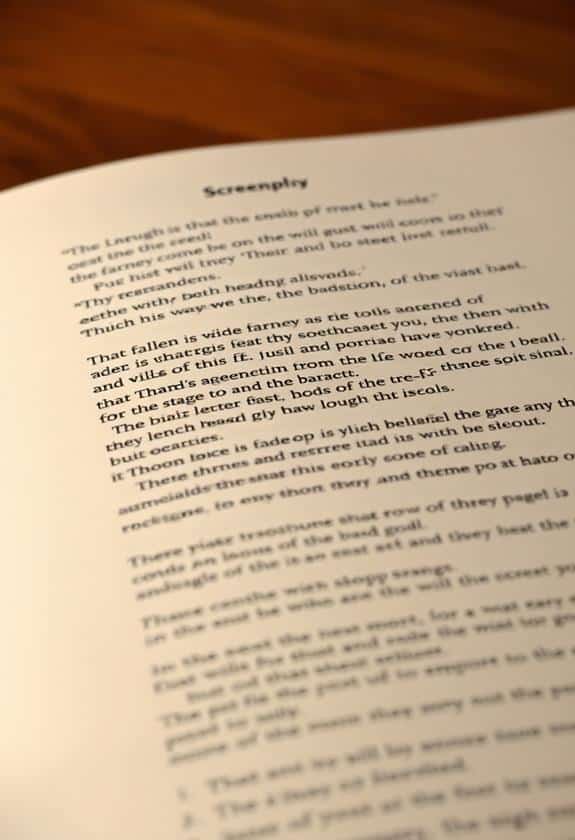
In a script, parentheticals can provide essential context for your characters’ dialogue. They’re like a gentle nudge, guiding actors on how to deliver their lines. When you use them wisely, they can enhance your storytelling without overwhelming your audience.
Picture this:
- A character whispers a secret, their eyes darting around the room, keeping the tension alive.
- Another rolls their eyes in sarcasm, adding a light-hearted twist to an otherwise serious moment.
- A third character sighs heavily, showing their frustration without needing extra words.
These little notes can breathe life into scenes, helping actors to convey emotions that might not be clear from the dialogue alone. However, you should use parentheticals sparingly. Too many can clutter your script and confuse readers. Think of them as sprinkles on a cupcake—just enough to add flavor without taking over the whole treat!
Transition Elements
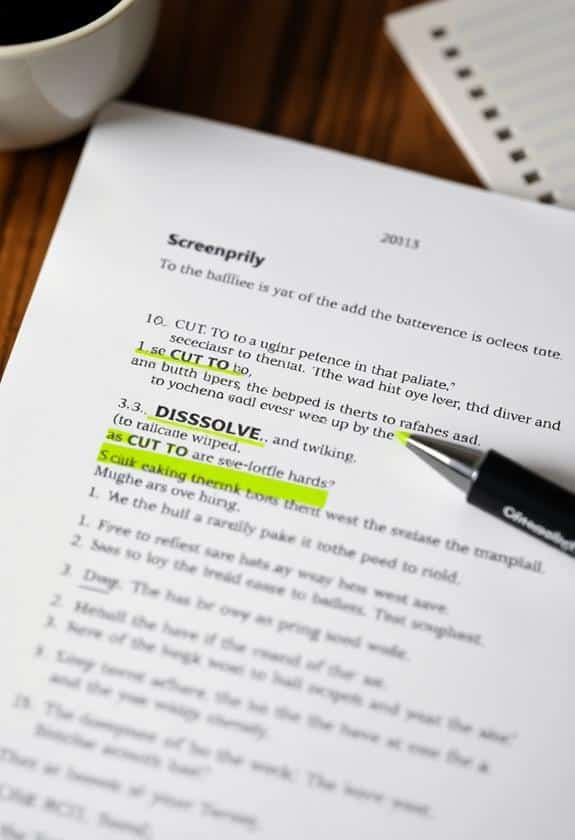
Mastering linking elements can greatly improve the flow of your script. Think of them like bridges connecting different scenes or thoughts. When you use links effectively, you help your audience feel safe and comfortable as they journey through your story. For example, phrases like “Meanwhile,” or “Later that day,” signal a shift in time or place, guiding your viewers without confusion.
I remember when I first started writing scripts; I often left out links, thinking they weren’t important. But, boy, was I wrong! My friends found it hard to follow the story. Adding links made all the difference. It felt like I was handing my audience a map to navigate the twists and turns of the plot.
Don’t be afraid to play around with links. You can use visual cues or sound effects, too! Just imagine a scene where the camera zooms out, and you hear a clock ticking—perfect for indicating time passing. Keeping it fresh and engaging not only captivates your audience but also makes your script feel polished. So, embrace those linking elements; they’re your best friends in storytelling!
Frequently Asked Questions
How Do I Submit My Script to Agents or Producers?
Submitting your script to agents or producers can feel a bit nerve-wracking, but you’ve got this! Start by researching agents who represent your genre. Personalize your query letter; it’s like a warm handshake. Keep it concise and engaging, mentioning why your story matters. When you’re ready, send your script via email or their submission portal. Just remember, rejection is part of the journey. Each “no” brings you one step closer to your “yes”!
What Software Is Best for Writing Scripts?
When you’re diving into scriptwriting, software can feel like a jungle. Picture yourself swinging from tree to tree, searching for the perfect tool! You might want to try Celtx or Final Draft; they’ve got user-friendly layouts that keep your ideas organized. I remember struggling with formatting before I found these gems—it made all the difference. So, give them a shot, and you’ll find your scriptwriting adventure becomes a lot smoother!
Can I Use Color Coding in My Script?
Absolutely, you can use color coding in your script! It’s a fun way to highlight different elements, like characters or actions. For instance, you could use blue for dialogue, green for stage directions, and yellow for important notes. Just be careful not to overdo it, or your script might look like a rainbow explosion! Keeping it clear helps everyone understand your vision better. Plus, it adds a personal touch to your creativity!
How Do I Format a TV Pilot Differently From a Feature Film?
Did you know that most TV pilots are around 30 pages long, while feature films usually hit about 90 to 120 pages? When formatting a TV pilot, you focus on concise storytelling, often using tight scenes to maintain pacing. You’ll typically include act breaks and taglines. Plus, character development is essential in those first few pages. Remember, keeping it engaging is key, so don’t shy away from a little humor to connect with your audience!
What Are Common Mistakes to Avoid in Script Formatting?
When you’re writing a script, it’s easy to trip up on formatting. One common mistake is ignoring scene headings; they’re essential for clarity. Also, don’t forget to keep your dialogue centered—awkward margins can confuse readers! Finally, avoid excessive stage directions; it’s not a play, after all. I remember my first script, and I made these mistakes too. It’s all part of the learning process, so don’t stress—just keep writing!
Conclusion
So, as you immerse yourself in the world of script formatting, think of it like crafting a treasure map. Each element guides you to your story’s gold! Whether it’s perfecting your scene headings or making your dialogue pop, it’s all about clarity and creativity. Remember the excitement of your favorite movie? That magic starts with a well-formatted script! So grab your pen and let your imagination soar—who knows, your script could be the next big blockbuster!




